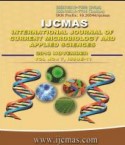


 National Academy of Agricultural Sciences (NAAS)
National Academy of Agricultural Sciences (NAAS)

|
PRINT ISSN : 2319-7692
Online ISSN : 2319-7706 Issues : 12 per year Publisher : Excellent Publishers Email : editorijcmas@gmail.com / submit@ijcmas.com Editor-in-chief: Dr.M.Prakash Index Copernicus ICV 2018: 95.39 NAAS RATING 2020: 5.38 |
Maize is the 3rd most important crop in the Bihar next to rice and wheat. It is grown throughout the year in one or other part of state. Due to continuous cropping of maize and other factors like improper use of fertilizers, pesticides and climate change, the disease problem has increased in tremendous proportion. Almost all parts of the maize plant are susceptible to numerous diseases that considerably reduce the yield and quality of the crop. Among the various diseases of maize, banded leaf and sheath blight caused by most widespread, destructive and versatile pathogen Rhizoctonia solani f. sp. sasakii has attained the status of economically important disease. The disease is difficult to control through either fungicides or crop rotation alone due to its soil borne nature and unavailability of resistance source. This disease causes direct loss due to premature death of early infected plants and stalk breakage and ear rot in the older plants. Losses in grain yield to the extent of 11 to 40 per cent under favourable conditions have been reported due to banded leaf and sheath blight. In Bihar this disease has been occurring in severe form in some maize growing districts and causing substantial losses in term of yield. The increasing of severity of this disease may be due to continuous growing of hybrids and favourable climate change for its pathogen growth and suitability. The consolidated knowledge presented in this review should help better understanding of the threat of banded leaf and sheath blight to maize cultivation in Bihar.
 |
 |
 |
 |
 |